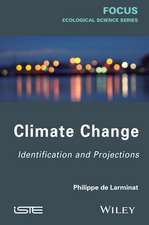Dry Scrubbing Technologies for Flue Gas Desulfurization
Editat de Barbara Toole-O'Neil, Ohio Coal Development Officeen Limba Engleză Paperback – 8 mai 2013
Dry Scrubbing Technologies for Flue Gas Desulfurization represents a body of research that was sponsored by the State of Ohio's Coal Development Office for the development of technologies that use coal in an economic, environmentally-sound manner. One of the project's major goals was the development of dry, calcium-based sorption processes for removing sulfur dioxide from the combustion gases produced by high-sulfur coal.
Dry Scrubbing Technologies for Flue Gas Desulfurization highlights a number of fundamental research findings that have had a significant and lasting impact in terms of scientific understanding. For example, the experimental investigation of the upper-furnace sulfur capture obtained time-resolved kinetic data in less than 100 millisecond time-scales for the first time ever, thereby revealing the true nature of the ultra-fast and overlapping phenomena. This was accomplished through the development of a unique entrained flow reactor system. The authors also identify a number of important areas for future research, including reaction mechanisms, sorbent material, transport effects, modeling, and process development.
Dry Scrubbing Technologies for Flue Gas Desulfurization will appeal to both chemical and environmental engineers who examine different ways touse coal in a more environmentally benign manner. It will make an essential reference for air pollution control researchers from coal, lime, cement, and utility industries; for government policy-makers and environmental regulatory agencies; and for those who teach graduate courses in environmental issues, pollution control technologies, and environmental policy.
| Toate formatele și edițiile | Preț | Express |
|---|---|---|
| Paperback (1) | 1245.66 lei 6-8 săpt. | |
| Springer Us – 8 mai 2013 | 1245.66 lei 6-8 săpt. | |
| Hardback (1) | 1249.00 lei 6-8 săpt. | |
| Springer Us – 29 noi 1998 | 1249.00 lei 6-8 săpt. |
Preț: 1245.66 lei
Preț vechi: 1519.09 lei
-18% Nou
Puncte Express: 1868
Preț estimativ în valută:
238.38€ • 247.46$ • 198.77£
238.38€ • 247.46$ • 198.77£
Carte tipărită la comandă
Livrare economică 22 martie-05 aprilie
Preluare comenzi: 021 569.72.76
Specificații
ISBN-13: 9781461372479
ISBN-10: 146137247X
Pagini: 908
Ilustrații: XL, 862 p.
Dimensiuni: 155 x 235 x 50 mm
Greutate: 1.25 kg
Ediția:1998
Editura: Springer Us
Colecția Springer
Locul publicării:New York, NY, United States
ISBN-10: 146137247X
Pagini: 908
Ilustrații: XL, 862 p.
Dimensiuni: 155 x 235 x 50 mm
Greutate: 1.25 kg
Ediția:1998
Editura: Springer Us
Colecția Springer
Locul publicării:New York, NY, United States
Public țintă
ResearchDescriere
Dry sulfurization processes offer the significant advantages of low capital and low operating costs when compared to wet desulfurization. They hold great potential for the economical reduction of sulfur emissions from power utilities that use high-sulfur coal.
Dry Scrubbing Technologies for Flue Gas Desulfurization represents a body of research that was sponsored by the State of Ohio's Coal Development Office for the development of technologies that use coal in an economic, environmentally-sound manner. One of the project's major goals was the development of dry, calcium-based sorption processes for removing sulfur dioxide from the combustion gases produced by high-sulfur coal.
Dry Scrubbing Technologies for Flue Gas Desulfurization highlights a number of fundamental research findings that have had a significant and lasting impact in terms of scientific understanding. For example, the experimental investigation of the upper-furnace sulfur capture obtained time-resolved kinetic data in less than 100 millisecond time-scales for the first time ever, thereby revealing the true nature of the ultra-fast and overlapping phenomena. This was accomplished through the development of a unique entrained flow reactor system. The authors also identify a number of important areas for future research, including reaction mechanisms, sorbent material, transport effects, modeling, and process development.
Dry Scrubbing Technologies for Flue Gas Desulfurization will appeal to both chemical and environmental engineers who examine different ways touse coal in a more environmentally benign manner. It will make an essential reference for air pollution control researchers from coal, lime, cement, and utility industries; for government policy-makers and environmental regulatory agencies; and for those who teach graduate courses in environmental issues, pollution control technologies, and environmental policy.
Dry Scrubbing Technologies for Flue Gas Desulfurization represents a body of research that was sponsored by the State of Ohio's Coal Development Office for the development of technologies that use coal in an economic, environmentally-sound manner. One of the project's major goals was the development of dry, calcium-based sorption processes for removing sulfur dioxide from the combustion gases produced by high-sulfur coal.
Dry Scrubbing Technologies for Flue Gas Desulfurization highlights a number of fundamental research findings that have had a significant and lasting impact in terms of scientific understanding. For example, the experimental investigation of the upper-furnace sulfur capture obtained time-resolved kinetic data in less than 100 millisecond time-scales for the first time ever, thereby revealing the true nature of the ultra-fast and overlapping phenomena. This was accomplished through the development of a unique entrained flow reactor system. The authors also identify a number of important areas for future research, including reaction mechanisms, sorbent material, transport effects, modeling, and process development.
Dry Scrubbing Technologies for Flue Gas Desulfurization will appeal to both chemical and environmental engineers who examine different ways touse coal in a more environmentally benign manner. It will make an essential reference for air pollution control researchers from coal, lime, cement, and utility industries; for government policy-makers and environmental regulatory agencies; and for those who teach graduate courses in environmental issues, pollution control technologies, and environmental policy.
Cuprins
1 Flue Gas Desulfurization for Acid Rain Control.- Abstract.- Background.- General Discussion of Current FGD Technology.- Overview.- Process Research Studies.- Wet/Wet Systems.- Dry/Dry Systems.- Wet/Dry Systems.- In-Fumace Injection.- Fundamentals.- Sulfur Evolution.- Modeling of Sorbent Reaction.- Technology.- Scope.- Economizer Zone Injection, 900–1200°F.- Injection of Hydrated Lime Downstream of the Air Preheater.- Fundamental Studies.- Dry/Dry Systems.- Wet/Dry Systems.- Spray Drying Absorption.- Description of the Spray Drying FGD Process.- Reagent Preparation.- Dryer Configuration.- Waste Disposal.- Process Chemistry.- Particulate Control.- Electrostatic Precipitator (ESP).- Fundamentals and Operating Parameters.- Operating Conditions.- ESP Design Considerations.- Fabric Filters (Baghouse).- Wet Scrubber.- Mechanical Particulate Control Devices.- Comparison of SO2 Removal in Fabric Filter (Baghouse) and ESPs.- Scope.- Sorbent Forms and Additives.- Calcium-Based Sorbents.- Chemical Form.- Calcium/Magnesium Ratio.- Morphology.- Preparation by Aqueous Hydration.- The Use of Additives to Enhance Reactivity.- Deliquescents, Buffers, and Sodium Additives.- Alcohol and Sucrose Hydration.- Silicate Additives.- Miscellaneous Additives - High Temperature Applications.- Contacting Flow Patterns and Multiphase Flows.- Contacting Flow Patterns and Some Novel Techniques.- Novel Techniques with FGD Applications.- Circulating Fluidized Bed Absorber.- Limestone Emission Control (LEC) System.- Novel Impeller Fluidizer.- Acoustic and Other Techniques.- Fundamental Fluid Mechanics, Mass and Heat Transfer Consideration in FGD Processes Involving Multiphase Flows.- Transport Properties of Dry Sorbent and Sorbent Slurries.- Conclusions.- In-Furnace Injection.- Economizer Zone Injection.- Injection of Hydrated Lime Downstream of the Air Preheater.- Spray Drying Absorption.- Particulate Control.- Future Research Needs.- Reaction Mechanisms and Sorbent Material.- Transport Effects and Modeling.- Process Development.- References.- 2 New Calcium-Based Sorbents for Flue Gas Desulfurization.- Abstract.- Properties of SO2.- Properties of CO2.- Properties Required in Sorbents.- Previously Considered Sorbents.- Techniques and Apparatus.- Infrared Spectroscopy.- X-Ray Powder Diffractometry.- BET Nitrogen Adsorption Surface Area Determinations.- Scanning Electron Microscopy.- SO2 Uptake Measurements.- Milling.- Shaking.- Survey of Calcium Silicates.- Tabulation of Known Calcium Silicates.- Further Description of C-S-H.- Conclusions.- Pure Calcium Silicate Sorbents.- Experimental.- Results and Discussion.- Conclusions.- SiO2-Modified Ca(OH)2 Sorbents.- Experimental.- Results and Discussion.- Conclusions.- Hydrated Ca3SiO5 AND ?-Ca2SiO4 Sorbents.- Experimental.- Results And Discussion.- Conclusions.- Hydrated Portland Cement Sorbents.- Experimental.- Results and Discussion.- Conclusions.- Summary.- List of Symbols and Abbreviations.- Notes and References.- 3 Fundamental Studies Concerning Calcium-Based Sorbents.- Abstract.- Literature.- Background.- Sorbent Preparation.- Limestone/Lime Characterization Study.- Limestone/Lime Samples.- Calcine Preparation.- Hydrate Preparation.- Sorbent Characterization.- Effect of Chemical Additives on Duct Injection/Spray Drying Performance.- Introduction/General Description.- Chemical Effects of Additives.- Model Comparisons.- Conclusions.- Recommendations.- Nomenclature.- References.- 4 Sorbent Transport and Dispersion.- Abstract.- Powder Characterization.- General Theory of Interparticle Forces.- Results of Powder Characterization.- Mechanical Properties.- Powder Dispersion.- Experimental.- Simulation of the Gas Flow Field in the Entrances.- Results and Discussion.- Modeling.- A Stochastic Model for Attrition of Sorbent Particles.- Integral Model for Powder Dispersion.- Nomenclature.- References.- 5 Transport Processes Involved in FGD.- Abstract.- Issues Regarding Transfer Processes for FGD Processes.- Literature Review.- Single Phase Flow Confined Ducted Jets.- Free Coaxial Jets.- Confined Jet Flow with Sudden Expansion.- Particle-Laden Flows, Turbulent Free Jet.- Concentric Jet Flows.- Pipe Flow.- Modeling.- Conclusions.- The Objectives of Investigation of Transport Processes in FGD.- Design Consideration for the Sorbent Injection Facility.- Geometric Similarity.- Particle-Laden Jet-to-Stream Momentum Flux Ratio.- Reynolds Number.- Stokes Number.- Froude Number.- Particle Loading and Particle-to-Fluid Density Ratio.- Sorbent Injection Facility.- Sorbent Injection (Particle-Laden Jet Test Facility).- Characteristics of Particle Phase (Glass Particles, Lime).- Glass Particles.- Lime Particles.- Laser Based Optical Measurement systems.- Calibration Tests.- Test Results and Discussion.- Axial Velocity Profile Across the Jet.- Particle-Laden Flow Measurements.- Axial Development Along the Centerline.- Axial Velocity Profile Across the Jet.- Jet Spreading Rate and Entrainment.- Measurement of Mean Particle Diameter and Particle Concentration.- Conclusions.- Single-Phase Flow.- Particle-Laden Flows.- Investigation of Spray-Concurrent Flow.- Experimental Setup.- Experimental Procedure.- Experimental Results.- Experimental Velocity Profiles and Prediction.- Flow Reversal.- Development of Criterion for Prediction of Flow Reversal.- Conclusions.- Particle-Laden Jet Reversal in Cocurrent Flow.- Summary.- Nomenclature.- References.- 6 High Temperature Desulfurization of Flue Gas Using Calcium-Based Sorbents.- Abstract.- Furnace Sorbent Injection (FSI).- High Temperature Phenomena: Calcination, Sintering and Sulfation.- Role of Surface Area and Porosity of the Calcines.- Role of Particle Size.- Roleof Sorbent Type.- Role of Temperature.- High-Temperature Entrained Flow Reactor Setup.- Entrained Flow Reactor System.- The Powder Feed System.- The High-Temperature Reactor.- The Probe System.- Particle Collection/Classification System.- Data Acquisition System.- Experimental Approach.- Operating Conditions.- On-Line Estimation of Particle Residence Time.- Post-Reaction Analyses of Data on Reaction Kinetics.- Ca-Based Sorbents Used in High-Temperature Flue Gas Desulfurization.- Experimental Results and Discussion: Calcination of Calcium Based Sorbents.- Effect of Temperature on Calcination.- Internal Surface Area Development with Calcination.- Effect of Particle Size on Calcination.- Development of Porosity and Pore Size Distribution of Calcined Sorbent Particles.- Experimental Results and Discussion: Sulfation of Calcium-Based Sorbents.- Effect of Temperature on the Sulfation of CaO and Ca(OH)2.- Effect of Initial Surface Area and Porosity on CaO Sulfation.- Effect of Particle Size on Sulfation.- Development of Internal Structural Properties During Sulfation.- Reaction Modeling for High-Temperature SO2 Sorption.- Calcination Modeling.- Sintering Modeling.- Comprehensive Sulfation Modeling.- Comparison of Experimental Data and Model Predictions.- Modified Calcium-Based Sorbent.- Surfactant Modifiers.- Lignosulfonate Modified Calcium Hydroxide.- Experimental Results and Discussion: Comparison Between Modified and Pure Calcium Hydroxide.- Conclusions.- Nomenclature.- Greek Letters.- Reference.- 7 Kinetic Studies on the Medium Temperature Ca(OH)2 Sorbent Injection FGD Process.- Abstract.- Background.- Entrained Flow Reactor.- Entrained Flow Reactor Construction and Operation.- Entrained Flow Reactor II.- Particle Heat Transfer Rate Determination.- Particle Residence Time Determination.- Dehydration Reaction of Ca(OH)2.- Literature Review.- Equilibrium of the Dehydration Reaction.- Dehydration Kinetics in the Entrained Flow Reactor.- Dehydration Model.- The Pseudohomogeneous Model.- Conclusions.- Carbonation Reaction.- Literature Review.- Carbonation ofCa(OH)2 in Entrained Flow Reactors.- Reactivity of CaO with CO2.- First-Order Deactivation Model.- Third-Older Deactivation Model.- General dth-Order Deactivation Model.- Model Application and Results.- Conclusions.- Sulfation Reaction.- Sulfation in an Entrained Flow Reactor.- Reactivity of CaO with SO2.- Sulfation Model.- Model Application and Results.- Conclusions.- Simultaneous Sulfation and Carbonation Reaction.- Literature Review.- Simultaneous Dehydration, Sulfation and Carbonation in the Entrained Flow Reactor.- Kinetic Model for Simultaneous Dehydration, Sulfation and Carbonation.- Reaction with Nascent CaCO3.- Activity.- Model Application.- Conclusions.- Recommendations.- References.- 8 Advances in Spray Drying Desulfurization for High-Sulfur Coals.- Abstract.- Literature Review.- General Spray Dryer Operations for Desulfurization.- Reagent Properties and Preparations.- Spray Drying Desulftirization.- Particulate Collection.- Recycle, Solid Waste Treatment and Disposal.- Methods of Increasing SO2 Removal and Sorbent Utilization.- Previous Lime and Limestone Dissolution Rate Studies.- Spray Dryer FGD Models.- Lime Dissolution Rate Studies.- Experimental Approach and Limestone Test Results.- Rotating Disk Technique and Lime Dissolution Rate Experimental Studies.- Pilot Spray Dryer Experimental Approach and Results.- Spray Dryer and Sampling System.- Baseline Test and Parameters that Affect Spray Dryer Desulrurization Processes.- Additives to Increase Ca(OH)2 Utilization.- Hydration of Fly Ash with Ca(OH)2 to Increase Sorbent Reactivity and Utilization.- Spray Dryer Modeling.- to “SPRAYMOD” and its Application to Baseline Test Results.- SO2 Absorption Process.- Modification of the Model by Hygroscopic Additive Effects: The Mechanism of Hygroscopicity.- Conclusions.- Nomenclature.- Greek Letters.- References.- 9 Low Temperature Dry Scrubbing/LEC Process Support.- Abstract.- Literature Review.- General Background.- Fixed-Bed Limestone Emission Control.- Moving-Bed Limestone Emission Control.- Limestone Solubilities and Dissolution Rates.- Process Theory and Model Development.- Assumptions.- Removal Rate of Sulfur Dioxide.- Interfacial Concentrations.- Reaction Site and Determination of Control.- Fixed-Bed Process Model.- Mass and Enthalpy Balances.- Model Simulations.- Moving-Bed Reactor Process Model.- Model Development.- Model Simulations.- Limestone Solubilities and Rates of Solubilization.- Theory.- Experimental.- Results and Discussion.- Conclusions and Recommendations: Solubilities and Rates of Dissolution.- Nomenclature.- References.- 10 Simulation and Optimization of a Granular Limestone Flue Gas Desulfurization Process.- Abstract.- Literature Review.- Transport and Reaction.- Economics.- Process Model.- Reactor Model.- Sorbent Blinding.- Dry Capture Model.- Differential Equations.- Solution Algorithm for Partial Differential Equations.- Calculation Speed Enhancement.- Cost Model.- Plant Simulation Model.- Optimization Algorithm.- Design Cases.- Computer Code.- Results.- Discussion of Results.- Conclusions.- Nomenclature.- References.- Appendix A-Governing Differential Equations.- Material and Enthalpy Balances.- Gas Phase Material Balances.- Solid Phase Material Balances.- Liquid Phase Material Balances.- Detailed Enthalpy Balances.- Appendix B Transport and Physical Property Correlations.- Sulfur (Dioxide) Transport Rate (gS).- Water Transport Rate (gW).- Gas/Liquid Heat Transport Rate (gg).- Gas/Liquid Heat Transfer Coefficient (hg).- Calcium Pseudo-Mass Transfer Coefficient (kmC).- Water Vapor Mass Transfer Coefficient (kmS).- Colbum j Factor for Heat and Mass Transfer in the Gas Phase (Jg).- Appendix C - Plant Simulation and Cost Model.- Mass Balance Equations.- Equipment Size Parameters.









